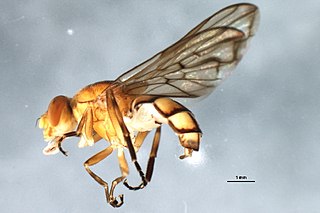
'Brachyopa notata , the Black-banded Sapeater , is a rare species of syrphid fly. It has been observed in Northeastern North America. Hoverflies get their names from the ability to remain nearly motionless while in flight. The adults are also known as flower flies for they are commonly found around and on flowers from which they get both energy-giving nectar and protein rich pollen. Larvae for this genus are of the rat-tailed type. B.notata larvae have not been described.

Callicera erratica , the Golden Pine Fly , is a rare species of syrphid fly observed in the Northeastern United States and Canada. Hoverflies can remain nearly motionless in flight. The adults are also known as flower flies for they are commonly found on flowers from which they get both energy-giving nectar and protein-rich pollen. Larvae live in water filled rotholes and cavities of old living conifers.

Teuchocnemis lituratus ,, the The Black Spur Fly , is an uncommon species of syrphid fly observed in the eastern half of North America. Syrphid flies are also known as Hover Flies or Flower Flies because the adults are frequently found hovering around flowers from which they feed on nectar and pollen. Adults are 10.5–15.4 mm (0.41–0.61 in)long, black with a yellow scutellum and hind tibia of male with spike. The larvae are unknown.

Temnostoma daochus , the Yellow-spotted Falsehorn, is a rare species of syrphid fly observed in the eastern United States. Hoverflies can remain nearly motionless in flight. The adults are also known as flower flies for they are commonly found on flowers, from which they get both energy-giving nectar and protein-rich pollen. Temnostoma adults are strong wasp mimics. The larvae burrow in moist decayed wood.

Eristalis dimidiata, the black-shouldered drone fly, is a species of hoverfly native to much of Canada and the eastern and northern United States. It flies year-round in southern areas and from late March to mid-November further north. It is one of the earliest hoverflies to fly in the spring, and as such likely overwinters as an adult. It lives primarily in forests.
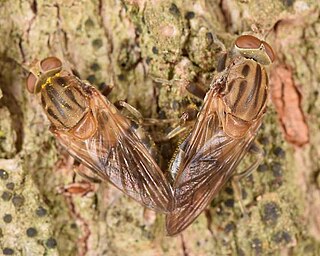
Brachyopa vacua , the Yellow-spotted Sapeater, is a rare, species of syrphid fly. It has been observed in Canada, Alaska and northern United States. Hoverflies get their names from the ability to remain nearly motionless while in flight. The adults are also known as flower flies for they are commonly found around and on flowers from which they get both energy-giving nectar and protein-rich pollen. Larvae for this genus are of the rat-tailed type. B.vacua larvae were collected from the juice of decaying fungi under dead bark.

Temnostoma venustum , the Black-banded Falsehorn , is a rare species of syrphid fly observed in the northeastern United States and adjacent Canada. Hoverflies can remain nearly motionless in flight. The adults are also known as flower flies for they are commonly found on flowers, from which they get both energy-giving nectar and protein rich pollen. Temnostoma adults are strong wasp mimics The larvae burrow in moist decayed wood.
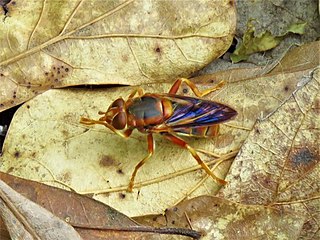
Teuchocnemis bacuntius ,, the Orange Spur Fly , is a rare species of syrphid fly observed in eastern half of the United States. Syrphid flies are also known as Hover Flies or Flower Flies because the adults are frequently found hovering around flowers from which they feed on nectar and pollen. Adults are 13.5–18.1 mm (0.53–0.71 in) long, orange with a swolen hind femur and the hind tibia of the male with a ventral spur. The larvae are unknown.
Hadromyia aepalius, the Sterling Quicksilver, is a rare species of syrphid fly found in eastern North America. Hoverflies get their names from the ability to remain nearly motionless while in flight. The adults are also known as flower flies for they are commonly found around and on flowers, from which they get both energy-giving nectar and protein-rich pollen.

Chalcosyrphus (Xylotomima) metallifer , the Orange-horned Leafwalker, is a rare species of syrphid fly observed in the Eastern United States. Hoverflies can remain nearly motionless in flight. The adults are also known as flower flies for they are commonly found on flowers, from which they get both energy-giving nectar and protein-rich pollen.
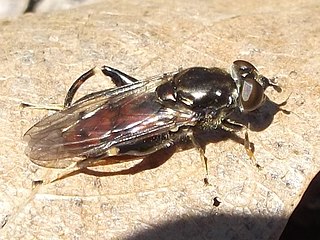
Chalcosyrphus (Xylotomima) libo, the Long-haired Leafwalker, is an uncommon species of syrphid fly observed in north-central North America. Hoverflies are able to remain nearly motionless in flight. The adults are also known as flower flies for they are commonly found around and on flowers, from which they get both energy-giving nectar and protein-rich pollen.
Chalcosyrphus parvus is a species of syrphid fly in the family Syrphidae.
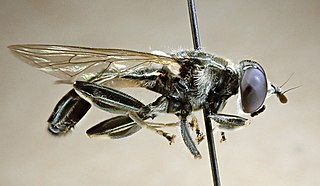
Xylota angustiventris,, the Two-spotted Leafwalker , is an uncommon species of syrphid fly observed in northeast North America. Syrphid flies are also known as Hover Flies or Flower Flies because the adults are frequently found hovering around flowers from which they feed on nectar and pollen. Adults are 12.2–14.4 mm (0.48–0.57 in) long, largely black with two yellow spots on the abdomen in the male? The larvae are not known, but in this genus, are likely to be found in tree holes or bark to feed on sap.
Xylota analis is a species of hoverfly in the family Syrphidae.

Sphegina (Sphegina) keeniana, the Peg-legged Pufftail, is a fairly common species of syrphid fly observed in Eastern North America. Hoverflies can remain nearly motionless in flight. The adults are also known as flower flies for they are commonly found on flowers, from which they get both energy-giving nectar and protein-rich pollen. Larvae found in accumulations of decaying sap under bark, usually in wet situations such as damp, shaded woodland and in partially submerged wood in streams and pools.
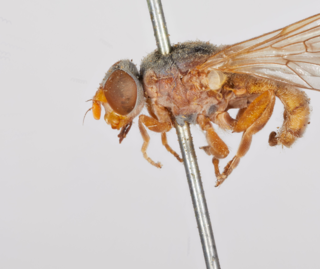
Brachyopa media ( Williston, 1882), is a rare species of syrphid fly. It has been observed in the Northeastern United States. Hoverflies get their names from the ability to remain nearly motionless while in flight. The adults are also known as flower flies for they are commonly found around and on flowers from which they get both energy-giving nectar and protein-rich pollen. Larvae for this genus are of the rat-tailed type. B.media larvae have not been described.
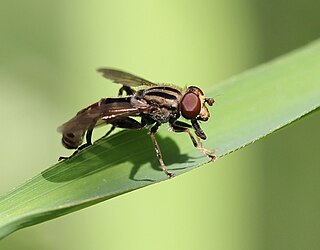
Anasimyia distincta, the short-spurred swamp fly, is a rare species of syrphid fly observed in The Northeastern United States and adjacent Canada. Hoverflies can remain nearly motionless in flight. The adults are also known as flower flies for they are commonly found on flowers from which they get both energy-giving nectar and protein rich pollen. Larvae of this genus are of the rat-tailed type living in aquatic environments.
Pipiza nigripilosa, the pale-haired pithead, is a common species of syrphid fly observed in the eastern United States. Hoverflies can remain nearly motionless in flight. The adults are also known as flower flies for they are commonly found on flowers, from which they get both energy-giving nectar and protein-rich pollen. Larvae when known are aphid predators.
Pipiza puella, the sumac gall pithead, is a species of syrphid fly observed in eastern and Central United States, Canada and Norway. Hoverflies can remain nearly motionless in flight. The adults are also known as flower flies for they are commonly found on flowers from which they get both energy-giving nectar and protein rich pollen. Larvae when known are aphid predators.

Leucozona americana Curran 1923, the American whitebelt fly, is an uncommon species of syrphid fly observed throughout northern North America. Hoverflies can remain nearly motionless in flight. The adults are also known as flower flies for they are commonly found on flowers, from which they get both energy-giving nectar and protein rich pollen. Larvae are not known.














